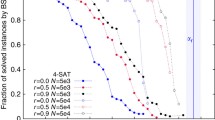Abstract
The average running time used by backtracking on random constraint satisfaction problems is studied. This time is polynomial when the ratio of constraints to variables is large, and it is exponential when the ratio is small. When the number of variables goes to infinity, whether the average time is exponential or polynomial depends on the number of variables per constraint, the number of values per variable, and the probability that a random setting of variables satisfies a constraint. A method for computing the curve that separates polynomial from exponential time and several methods for approximating the curve are given. The version of backtracking studied finds all solutions to a problem, so the running time is exponential when the number of solutions per problem is exponential. For small values of the probability, the curve that separates exponential and polynomial average running time coincides with the curve that separates an exponential average number of solutions from a polynomial number. For larger probabilities the two curves diverge. Random problems similar to those that arise in understanding line drawings with shadows require a time that is mildly exponential when they are solved by simple backtracking. Slightly more sophisticated algorithms (such as constraint propagation combined with backtracking) should be able to solve these rapidly.
Similar content being viewed by others
Explore related subjects
Discover the latest articles, news and stories from top researchers in related subjects.References
J.R. Bitner and E.M. Reingold, Backtrack programming techniques, Comm. ACM 18 (1975) 651–655.
C.A. Brown and P.W. Purdom, An average time analysis of backtracking, SIAM J. Comput. 10 (1981) 585–593.
K.M. Bugrara, On the average case analysis of some satisfiability model problems, Information Sciences 40 (1986) 21–37.
J. Franco, On the probabilistic performance of algorithms for the satisfiability problem, Information Processing Letters 23 (1986) 103–106.
J. Franco, Elimination of infrequent variables improves average case performance of satisfiability algorithms, SIAM J. Comput. 20 (1991) 1119–1127.
J. Gu, Local search for satisfiability (SAT) problems, IEEE Trans. on Systems, Man, and Cybernetics 23 (1993) 1108–1129.
R.M. Haralick and G.L. Elliot, Increasing tree search efficiency for constraint satisfaction problem, Artificial Intelligence 14 (1980) 263–313.
B. Monien, E. Speckenmeyer and O. Vornberger, Superlinear speedup for parallel backtracking, University of Paderborn Report.
B. Nudel, Consistent-labeling problems and their algorithms: expected-complexities and theory-based heuristics, Artificial Intelligence 21 (1983) 135–178. Also in: Search and Heuristics, ed. J. Pearl (North-Holland, New York, 1983) pp. 135–178.
P.W. Purdom, Jr., Search rearrangement backtracking and polynomial average time, Artificial Intelligence 21 (1983) 117–133.
P.W. Purdom, Jr., Solving satisfiability with less searching, IEEE Trans. on Pattern Analysis and Machine Intelligence PAMI-4 (1984) 510–513.
P.W. Purdom, Jr., A survey of average time analyses of satisfiability algorithms, Journal of Information Processing 13 (1990) 449–455.
P.W. Purdom, Jr. and C.A. Brown, Polynomial-average-time satisfiability problems, Information Sciences 41 (1987) 23–42.
P.W. Purdom, Jr., C.A. Brown and E.L. Robertson, Backtracking with multi-level dynamic search rearrangement, Acta Informatica 15 (1981) 99–113.
P.W. Purdom and G.N. Haven, Probe order backtracking, SIAM J. Comput. (in press).
B. Selman, H. Levesque and D. Mitchell, A new method for solving hard satisfiability problems, in: Proceedings of AAAI'92 (1992) pp. 440–446.
Y.K. Tsuji, A systematic selection of efficient strategies for solving satisfiability problems, Ph.D. Thesis, University of California at Santa Cruz (in preparation).
D.L. Waltz, Understanding line drawings of scenes with shadows, in: The Psychology of Computer Vision, ed. P.H. Winston (McGraw-Hill, New York, 1975) pp. 19–91.
P.H. Winston, Machine vision, in: The Psychology of Computer Vision, ed. P.H. Winston (McGraw-Hill, New York, 1975) pp. 1–17.
Author information
Authors and Affiliations
Rights and permissions
About this article
Cite this article
Purdom, P.W. Backtracking and random constraint satisfaction. Annals of Mathematics and Artificial Intelligence 20, 393–410 (1997). https://doi.org/10.1023/A:1018944814355
Issue Date:
DOI: https://doi.org/10.1023/A:1018944814355




